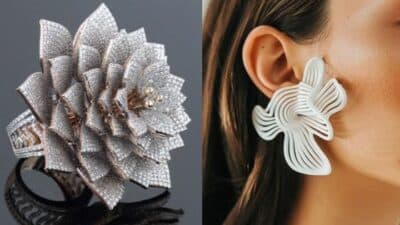3D printing has revolutionized how we approach storage and organization in our homes and workspaces. Instead of settling for generic, one-size-fits-all solutions, you can now create custom organizers that perfectly fit your specific needs and available space.
The beauty of 3D printed organizers lies in their complete customization and cost-effectiveness compared to traditional storage solutions. From modular drawer systems that adapt to your changing needs to specialized tool holders designed for your exact equipment, these printable designs offer practical solutions for every organizational challenge you face.
1) Modular Drawer Organizer by wbu42
This fully parametric drawer organizer system solves the common problem of drawer dividers that don’t maximize space efficiently. You can customize every aspect of the design to match your specific drawer dimensions and storage needs.
The system offers complete flexibility in creating compartments. You define your own design parameters to build the perfect layout for your items. This eliminates the frustration of generic organizers that leave unused space.
For quick results, you can download pre-created STL files and start printing immediately. The modular design allows you to mix and match different compartment sizes as your storage needs change.
The organizer works well with standard 3D printing settings. You can use PLA for testing or PETG for final versions. Most parts print without infill, making them quick and economical to produce.
The parametric nature means you’re not limited to standard sizes. Whether you need tiny compartments for screws or larger sections for tools, you can create exactly what fits your workflow.
This system excels at organizing small parts, craft supplies, and workshop tools. The modular approach lets you reconfigure your storage without reprinting everything.
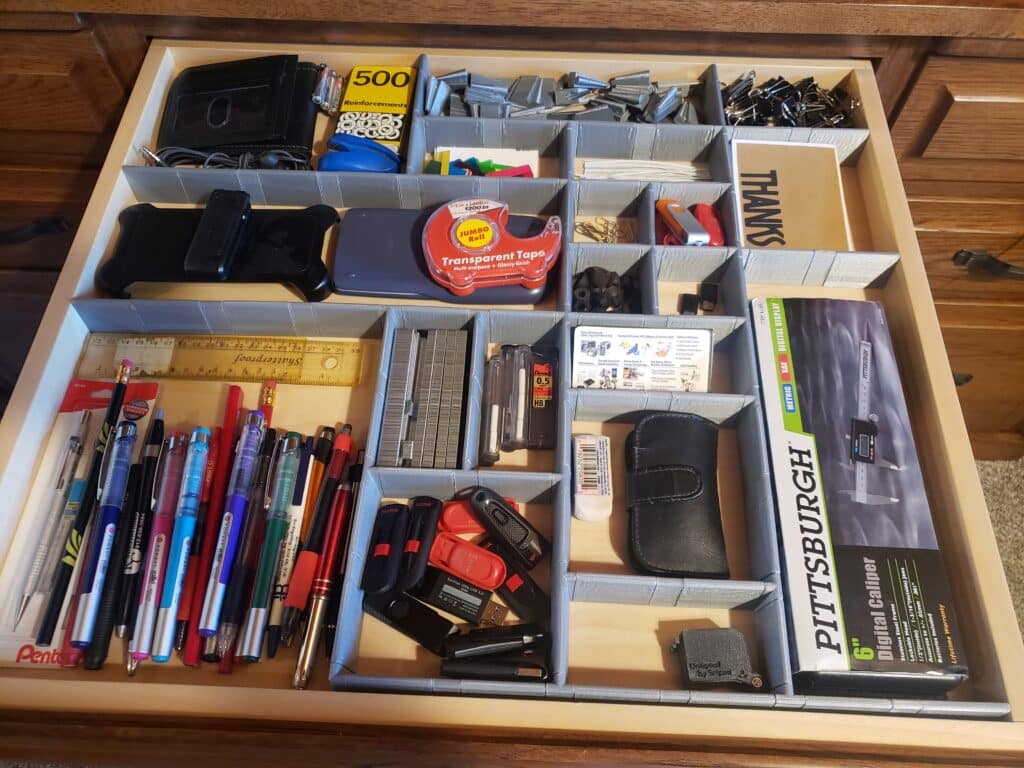
https://www.thingiverse.com/make:1062960
2) OrganiZen Modular Desk Organizer
OrganiZen offers a customizable 3D-printed solution for your workspace organization needs. This modular system lets you arrange compartments according to your specific requirements.
The design focuses on bringing order and simplicity to your desk. You can easily customize the layout to match your workflow and available space.
This organizer handles various office essentials effectively. You can store pens, sticky notes, cables, and other small items in dedicated compartments.
The modular nature means you can reconfigure the system as your needs change. You can add or remove compartments without replacing the entire organizer.
The 3D-printed construction allows for precise fitting and durability. You can print additional modules when you need to expand your storage capacity.
OrganiZen works well for both home offices and professional workspaces. The clean design maintains a professional appearance while maximizing functionality.
You can download the files and print them on most standard 3D printers. The modular components connect securely without requiring additional hardware or adhesives.
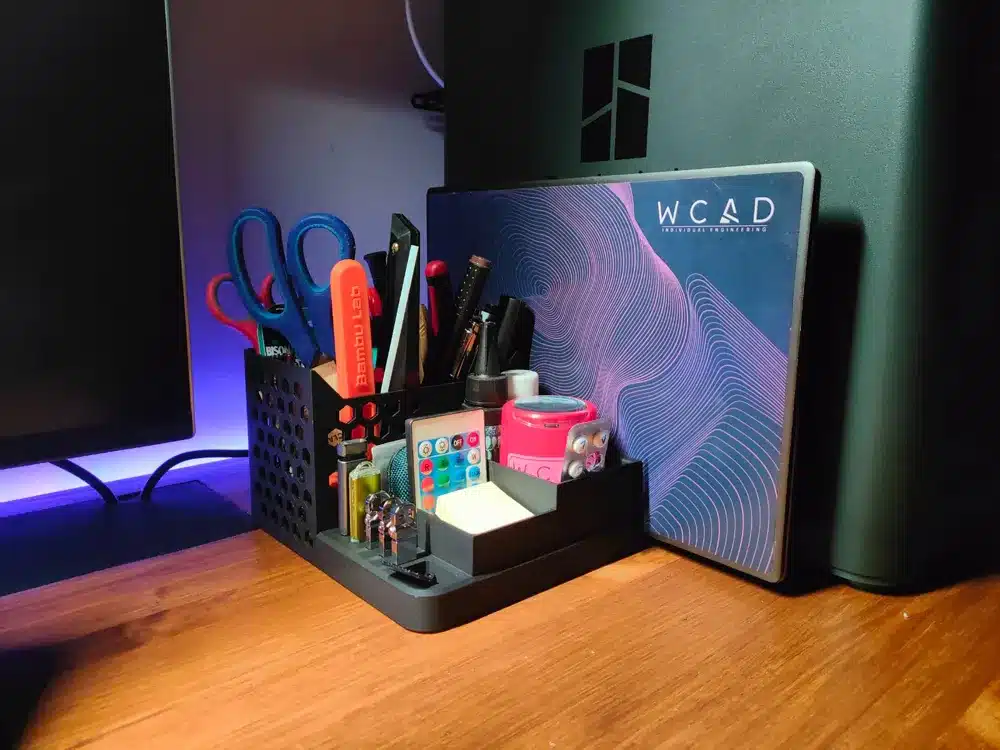
https://makerworld.com/en/models/61938-desk-organizer?from=search#profileId-64388
3) Potters Bespoke Custom Drawer Bins
Potters Bespoke Bins offers custom 3D printed drawer organizers designed to fit your specific drawer dimensions. These organizers are created using precise measurements to ensure a perfect fit.
You can order these custom bins to match your exact storage needs. The company focuses on creating organizers that maximize your available drawer space.
The bins are made through 3D printing technology, allowing for customization that traditional organizers cannot provide. Each organizer is tailored to your drawer’s unique shape and size.
You provide your drawer measurements and storage requirements to receive a custom solution. This eliminates the common problem of wasted space that occurs with standard-sized organizers.
The service combines precision engineering with practical storage solutions. Your custom bins arrive ready to install and use immediately.
These organizers work well for various items including tools, utensils, and small parts. The custom fit ensures items stay in place and remain easily accessible.
The 3D printing process allows for complex shapes and configurations that match your specific organizational needs. You get a storage solution designed specifically for your space and requirements.
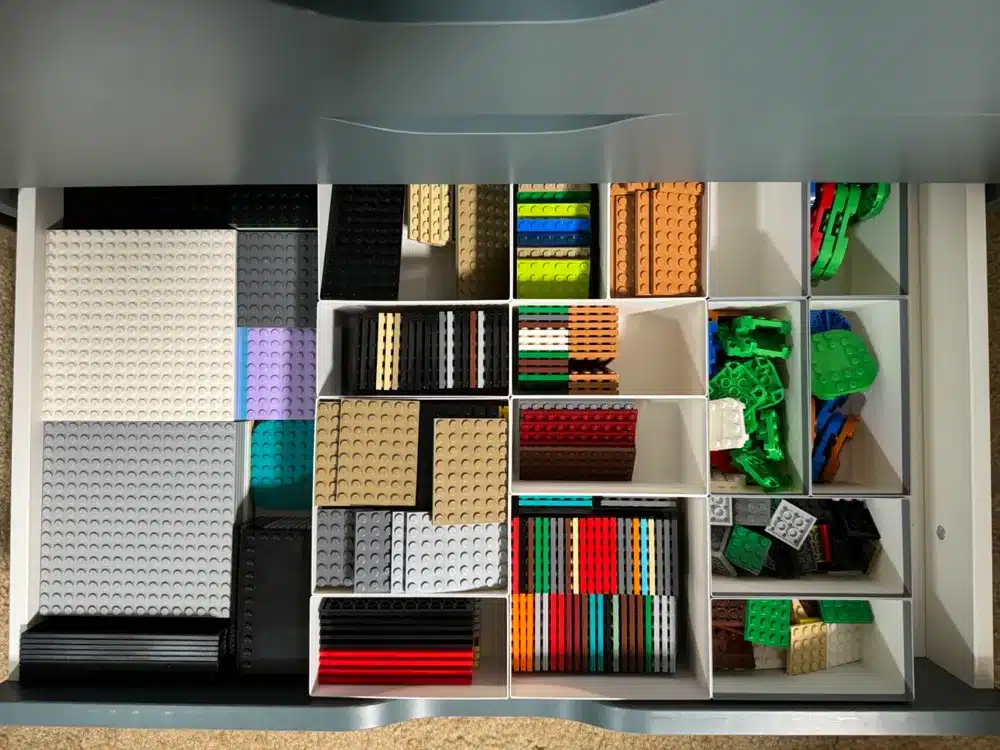
4) Thread Boards Organizational System
Thread Boards stands out as one of the most practical 3D printed organization systems available today. The system uses innovative threaded peg boards that allow you to create customized storage solutions for your specific needs.
You get access to over 25,000 STL files and size variations when you purchase the system. This massive catalog ensures you can find the right organizer for almost any item you need to store.
The threaded design sets Thread Boards apart from other peg board systems. You can securely attach accessories without worrying about them falling off or becoming loose over time.
The system features modular components that work together seamlessly. You can mix and match different organizers to create the perfect storage wall for your garage, workshop, or office.
Thread Boards offers accessories ranging from simple shelves to specialized holders for tools and equipment. The variety means you can organize everything from small screws to larger hand tools.
The system continues to expand with new designs regularly added to the catalog. This ongoing development ensures you’ll always have fresh organization options as your storage needs change.
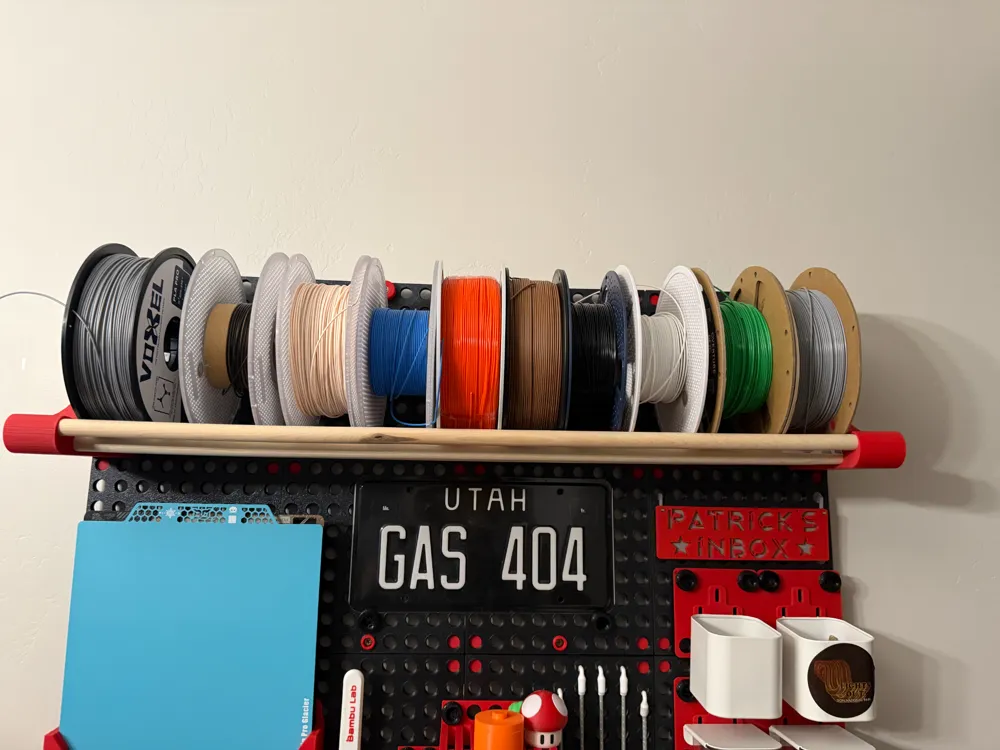
https://makerworld.com/en/models/816928-thread-boards-shelf-system?from=search#profileId-759295
5) 3D Printed Cable Spool Holders
Cable spool holders help you manage loose cables and cords around your workspace. These organizers keep your cables wound neatly and prevent tangling.
You can find thousands of cable spool holder designs on popular 3D printing platforms. Most designs are customizable, allowing you to resize them based on your cable thickness and length.
The basic design consists of a circular base with side walls and a removable top lid. You wind your cable around the spool and secure it with the lid.
These holders work well for USB cables, charging cords, and headphone wires. You can print different sizes for various cable types in your collection.
Many designs feature improvements over basic spools, including easier rotation mechanisms and better cable access. Some models include labeling areas so you can identify cables quickly.
The print time is typically fast, and most designs use minimal filament. You can batch print multiple holders to organize all your cables at once.
Cable spool holders are particularly useful for people who work from home or manage multiple electronic devices. They transform cluttered cable drawers into organized storage systems.
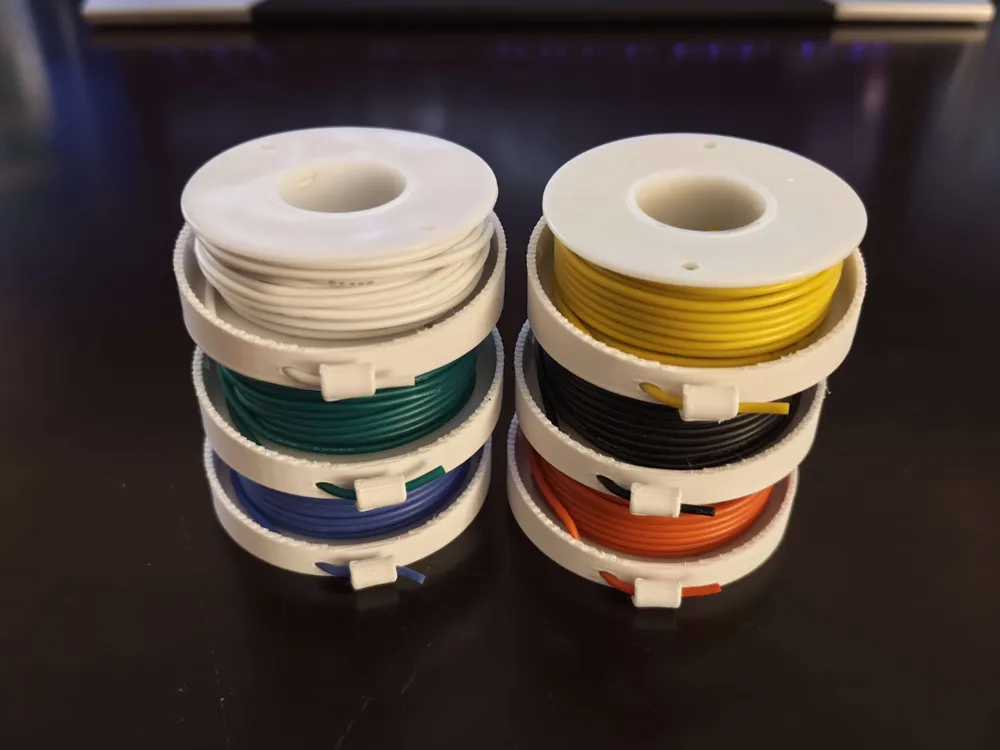
https://makerworld.com/en/models/1583044-cable-spool-holder-with-cableclip?from=search
6) Customizable Tool Holders for Workshops
Workshop environments require specialized organization solutions that standard storage systems cannot provide. 3D printed tool holders offer the flexibility to create custom designs that match your specific tools and workspace layout.
You can design holders that accommodate unique tool shapes and sizes. This eliminates the frustration of trying to fit specialized equipment into generic organizers that were never meant for your particular needs.
Custom tool holders maximize workspace efficiency by utilizing vertical wall space and awkward corners. You can create mounting systems that attach directly to pegboards, workbenches, or tool chests.
The ability to print multiple copies allows you to establish consistent organization across different work areas. This creates a systematic approach where every tool has a designated home location.
Design modifications are straightforward when your tool collection changes. You can adjust holder dimensions, add new compartments, or create entirely new configurations without purchasing commercial alternatives.
Material selection impacts durability and functionality. PETG and ABS plastics provide better chemical resistance for workshops that use solvents or cutting fluids compared to standard PLA filament.
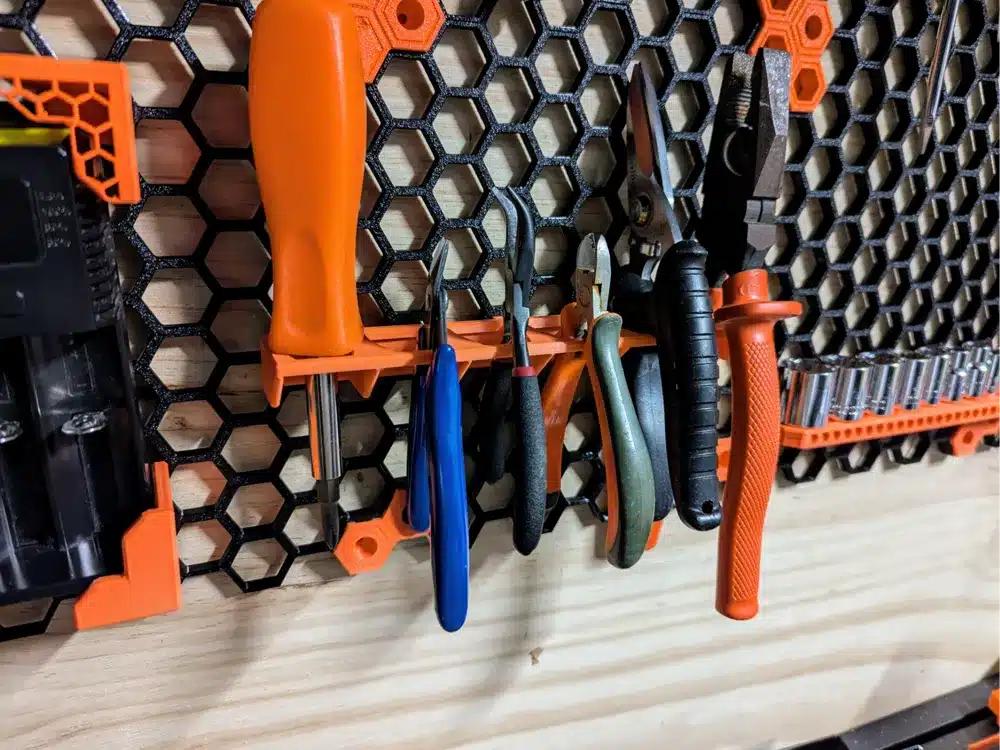
https://makerworld.com/en/models/556373-hsw-tool-holder?from=search#profileId-475183
7) Multi-Compartment Desk Tray
Multi-compartment desk trays offer the most versatile storage solution for your workspace essentials. These 3D printed organizers feature strategically placed compartments of various sizes to accommodate different office supplies.
You can store pens, paperclips, business cards, and small tools in designated sections. The compartments prevent items from mixing together and make everything easily accessible.
Most designs include both large and small compartments. The larger sections work well for notebooks, tablets, or bulky items. Smaller slots are perfect for pens, erasers, and coins.
The modular nature of these trays allows you to customize your storage setup. You can print multiple trays and arrange them according to your specific needs.
These organizers typically feature a sleek, modern design that complements any workspace. The 3D printing process allows for precise compartment sizing and smooth finishes.
Installation requires no assembly – simply place the tray on your desk and start organizing. The stable base prevents sliding and keeps everything in place during daily use.
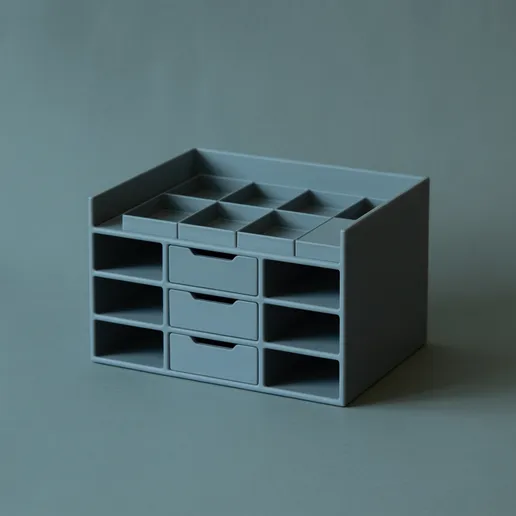
8) Expandable 3D Printed Storage Racks
Expandable storage racks offer flexible organization solutions that grow with your needs. These modular systems let you add sections as your collection expands.
You can print stackable shelf units for hard drives, tools, or craft supplies. The modular design means you start small and build upward or outward over time.
Popular expandable rack designs include the Kumiko storage system with its decorative aesthetic. This system provides clean, functional organization with stackable components that maintain visual appeal.
HDD storage racks represent another practical application. These modular shelves accommodate 3.5-inch drives with mounting holes for cooling fans and secure drive binding.
The key advantage of expandable racks is their adaptability. You print additional modules when you need more storage space without replacing the entire system.
Most expandable rack designs use simple connection methods like tabs, clips, or interlocking joints. This makes assembly straightforward without requiring additional hardware.
Print settings typically call for 20% infill and 0.25mm layer height for adequate strength. Use PLA plastic with a small brim for best bed adhesion during printing.
These storage solutions work well in workshops, offices, and hobby spaces where storage needs change frequently.
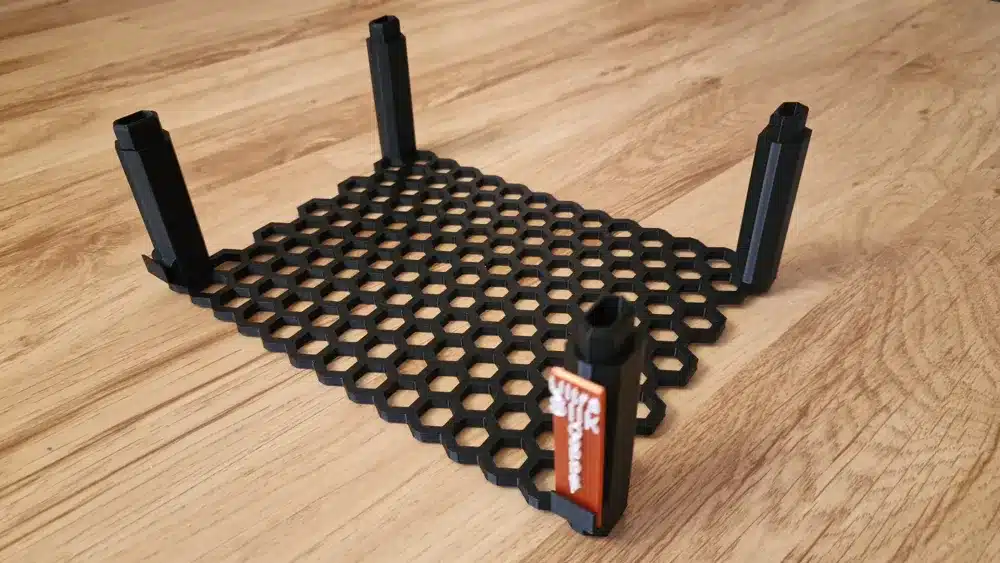
Benefits of 3D Printed Organizers
3D printed organizers offer personalized solutions that match your exact storage requirements while providing significant cost savings over manufactured alternatives. The eco-friendly materials used in these prints create sustainable storage systems that reduce waste and environmental impact.
Customization for Specific Needs
3D printing allows you to create organizers that fit your exact dimensions and requirements. You can design compartments for specific tools, adjust heights for different items, and create unique shapes that work in your space.
Your printer can produce organizers that match unusual drawer sizes or awkward storage areas where store-bought options won’t fit. This precision eliminates wasted space and maximizes storage efficiency.
Key customization options include:
- Adjustable compartment sizes
- Modular designs that connect together
- Specific heights for different items
- Custom labeling and identification systems
You can modify designs instantly when your storage needs change. Adding new compartments or adjusting existing ones requires only a design update and a new print.
The ability to create organizers for specialized items like electronics, crafting supplies, or professional tools means everything has its designated place. This level of customization isn’t available with mass-produced alternatives.
Cost-Effectiveness Compared to Store-Bought Alternatives
3D printed organizers typically cost 50-80% less than similar store-bought products. A drawer organizer that costs $25 in stores can be printed for $3-5 in materials.
The upfront investment in filament pays for itself after printing just a few organizers. Most home prints use PLA plastic, which costs approximately $0.02-0.05 per gram.
Cost comparison example:
- Store-bought desk organizer: $15-30
- 3D printed equivalent: $2-6
- Material savings: 70-85%
You eliminate shipping costs and waiting times since you produce items at home. This immediate availability saves both money and time when you need storage solutions quickly.
The ability to print replacement parts or additional components extends the life of your organizational systems. Instead of buying entirely new units, you print only what you need.
Sustainability and Material Choices
PLA filament, the most common 3D printing material, comes from renewable plant sources like corn starch. This biodegradable plastic reduces environmental impact compared to petroleum-based storage products.
3D printing creates minimal waste since you use only the material needed for each project. Failed prints can be recycled into new filament, creating a closed-loop system.
Sustainable material options:
- PLA: Biodegradable, plant-based, food-safe
- PETG: Recyclable, durable, chemical-resistant
- Wood-filled filaments: Contains real wood particles, biodegradable
You reduce packaging waste by eliminating cardboard boxes, plastic wrapping, and shipping materials. This direct production method cuts transportation emissions significantly.
The longevity of 3D printed organizers means fewer replacements over time. Quality prints last for years with normal use, reducing the need for frequent repurchasing.
Local production eliminates the carbon footprint associated with manufacturing and shipping from distant facilities. Your printer creates items on-demand without excess inventory or waste.
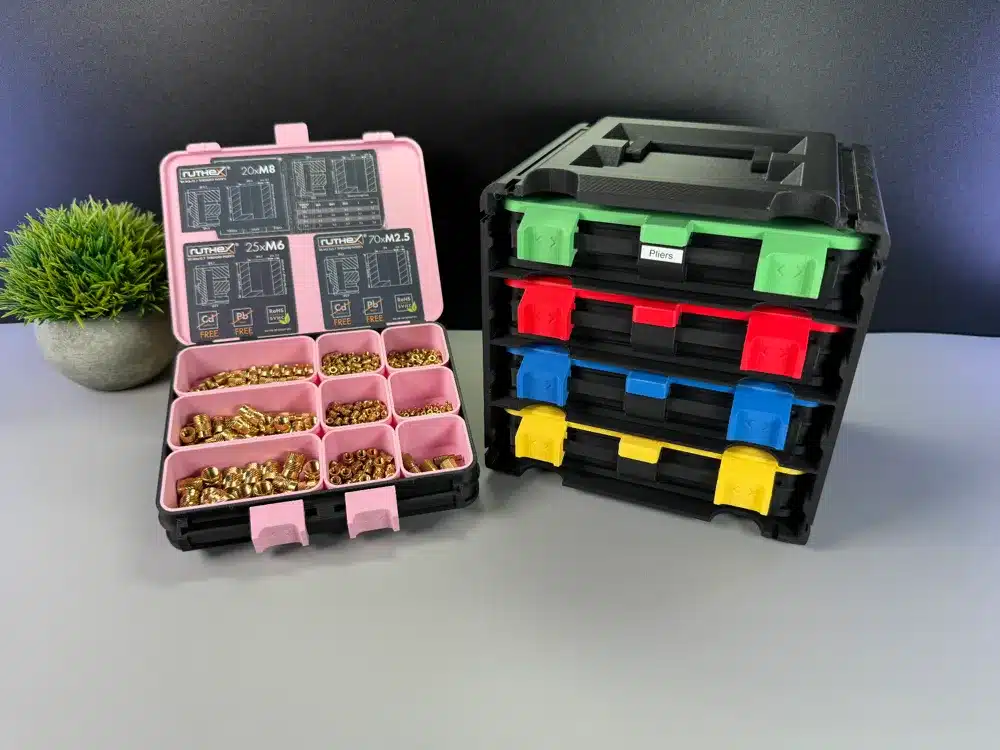
https://makerworld.com/en/models/539768-organizer-box?from=search#profileId-457124
Tips for Designing and Printing Organizers
Successful organizer projects require careful material selection, precise dimensional planning, and proper finishing techniques. The right filament choice and attention to fit tolerances will determine how well your organizers function in daily use.
Choosing the Right Filament
PLA works best for most desktop organizers due to its ease of printing and adequate strength. It handles light to moderate loads without warping during printing.
PETG offers superior durability for organizers that will see heavy use. This material resists cracking better than PLA and maintains flexibility under stress.
ABS suits organizers exposed to heat or requiring maximum impact resistance. However, it requires an enclosure and heated bed for consistent results.
Consider wood-filled filaments for aesthetic appeal in visible storage areas. These materials sand and stain like real wood while maintaining printability.
Transparent filaments work well for parts bins where you need to see contents. Use slower print speeds to achieve better clarity.
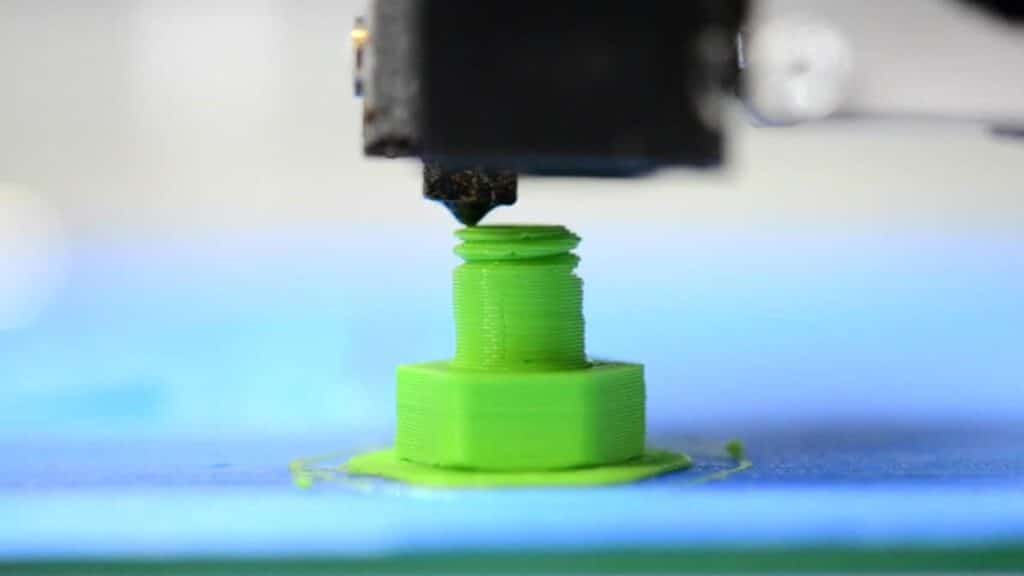
Achieving Precise Fits and Tolerances
Start with 0.2mm clearance for sliding parts and adjust based on your printer’s accuracy. Test small prototypes before printing full-size organizers.
Horizontal holes typically print 0.1-0.2mm smaller than designed. Vertical holes usually match design dimensions more closely.
Print tolerance test strips with various gap sizes to determine your printer’s specific characteristics. This saves material and time on large projects.
Design snap-fit connections with 0.3-0.5mm flex allowance for removable components. Too tight breaks parts, too loose creates rattling.
Layer height affects fit quality. Use 0.15-0.2mm layers for organizers requiring precise fits rather than 0.3mm draft settings.
Post-Processing for Durability
Sand contact surfaces with 220-grit paper to remove layer lines that cause wear. Focus on sliding surfaces and connection points.
Apply acetone vapor smoothing to ABS organizers for professional appearance and reduced friction. This process strengthens layer adhesion.
Drill out holes with appropriate sized bits for better dimensional accuracy than printed holes. This ensures consistent fit for hardware or tools.
Chamfer sharp edges with a file or sandpaper to prevent stress concentrations that lead to cracking. Pay attention to corners and thin walls.
Consider chemical welding for permanent joints using compatible solvents. This creates stronger bonds than mechanical fasteners alone.
- 0shares
- Facebook0
- Pinterest0
- Twitter0


